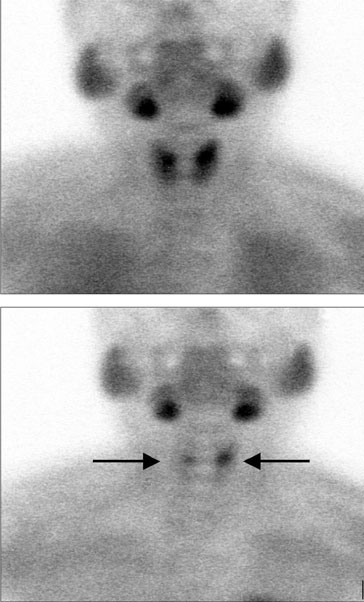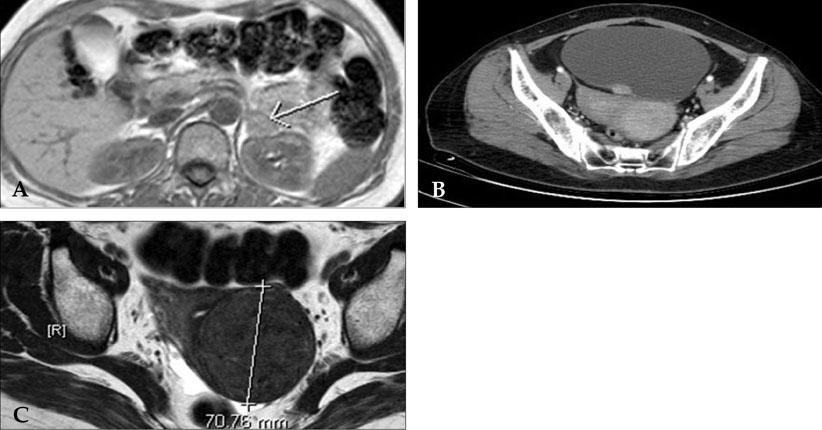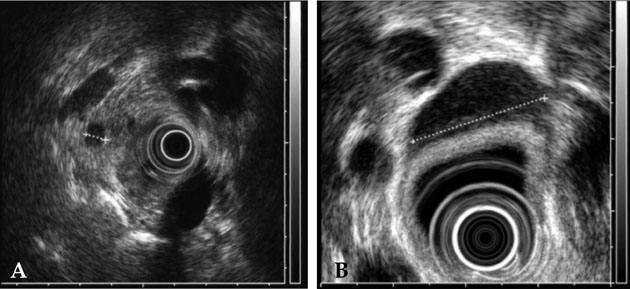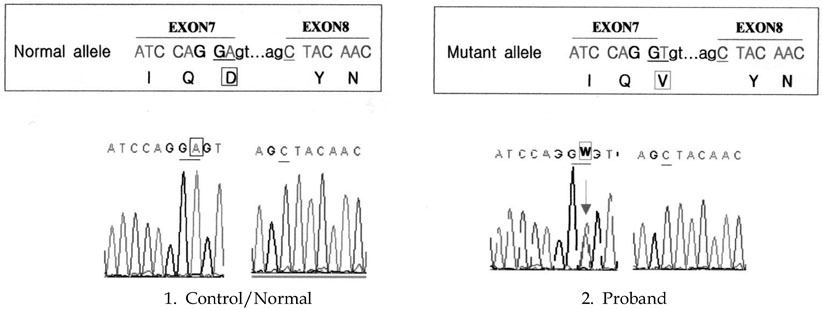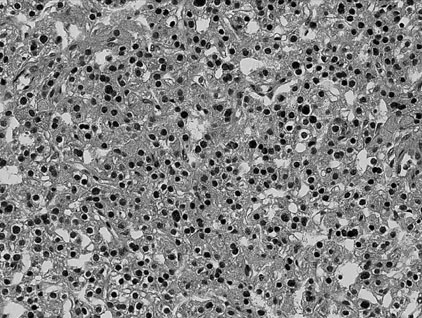Yonsei Med J.
2008 Aug;49(4):655-661. 10.3349/ymj.2008.49.4.655.
Multiple Endocrine Neoplasia Type 1 with Multiple Leiomyomas Linked to a Novel Mutation in the MEN1 Gene
- Affiliations
-
- 1Department of Internal Medicine, Yonsei University College of Medicine, Seoul, Korea. yumie@yuhs.ac
- 2Department of Pathology, Yonsei University College of Medicine, Seoul, Korea.
- 3Department of Endocrine Research Institute, Yonsei University College of Medicine, Seoul, Korea.
- 4Department of Medical Genetics, Ajou University School of Medicine, Suwon, Korea.
- KMID: 1793203
- DOI: http://doi.org/10.3349/ymj.2008.49.4.655
Abstract
- Multiple endocrine neoplasia type 1 (MEN1) is an autosomal dominantly inherited syndrome. MEN1 is characterized by the presence of functioning and nonfunctioning tumors or hyperplasia of the pituitary gland, parathyroid glands, and pancreatic islet cells. In addition, MEN1 carriers can have adrenal or thyroid tumors and non-endocrine tumors, such as lipomas, angiofibromas, and leiomyomas. Although leiomyoma is not a major component of MEN1, it is thought to occur more frequently than expected. However, there has been no report of a case of MEN1 with leiomyoma in Korea so far. This report describes a patient with multiple leiomyomas in MEN1. A 50-year-old woman was referred for further evaluation of elevated calcium levels and osteoporosis. Biochemical abnormalities included hypercalcemia with elevated parathyroid hormone. There was hyperprolactinemia with pituitary microadenoma in sella MRI. An abdominal MRI demonstrated adrenal nodules and leiomyomas in the bladder and uterus. Endoscopic ultrasonography demonstrated esophageal leiomyoma and pancreatic islet cell tumor. A subtotal parathyroidectomy with thymectomy was performed. Sequencing of the MEN1 gene in this patient revealed a novel missense mutation (D350V, exon 7). This is the first case of MEN1 accompanied with multiple leiomyomas, parathyroid adenoma, pituitary adenoma, pancreatic tumor, and adrenal tumor.
MeSH Terms
Figure
Reference
-
1. Doherty GM. Multiple endocrine neoplasia type 1. J Surg Oncol. 2005. 89:143–150.
Article2. McKeeby JL, Li X, Zhuang Z, Vortmeyer AO, Huang S, Pirner M, et al. Multiple leiomyomas of the esophagus, lung, and uterus in multiple endocrine neoplasia type 1. Am J Pathol. 2001. 159:1121–1127.3. Ikota H, Tanimoto A, Komatsu H, Ozawa Y, Matsushita H. Ureteral leiomyoma causing hydronephrosis in Type 1 multiple endocrine neoplasia. Pathol Int. 2004. 54:457–459.
Article4. Schussheim DH, Skarulis MC, Agarwal SK, Simonds WF, Burns AL, Spiegel AM, et al. Multiple endocrine neoplasia type 1: new clinical and basic findings. Trends Endocrinol Metab. 2001. 12:173–178.5. Oh KY, Lee NS, Jang DS, You KH, Baek HS. Multiple Endocrine Neoplasm Type I: a Case Report. Korean J Intern Med. 1986. 31:229–235.6. Chun SW, Moon IS, Kim JG, Park WB, Chun JS, Park WS, et al. Multiple Endocrine Neoplasm, Type I. J Korean Surg Soc. 1991. 40:684–690.7. Kim HK, Kim CH, Park JY, Shong YK, Lee KU, Kim GS. Clinical Features of Multiple Endocrine Neoplasia type I in Koreans. J Korean Soc Endocrinol. 1996. 11:163–174.8. Yoo SJ, Cha BY, Lee KW, Son HY, Kang SK, Won JM, et al. A case of multiple endocrine neoplasia type 1. J Korean Soc Endocrinol. 1997. 12:111–119.9. Hong SB, Hong SJ, Song YK, Kim KS, Kim SW, Lee KU, et al. A case of multiple endocrine neoplasia type I presented with secondary amenorrhea and osteoporosis. J Korean Soc Endocrinol. 1998. 13:684–689.10. Choe WH, Park YJ, Hong IC, Park SH, Choi SC, Lee HR, et al. A case of multiple endocrine type I presenting with a watery diarrhea. J Korean Soc Endocrinol. 2001. 16:231–237.11. Lee SK, Lee KW, Kim HJ, Lee SH, Yoon JG, Han SW, et al. Zollinger-Ellison Syndrome Associated with Multiple Endocrine Neoplasia Ia. Korean J Gastrointest Endosc. 2001. 22:383.12. Lee YM, Jung HY, Choi SY, Kang HH, Myung SJ, Yang SK, et al. A case of metachronous multiple endocrine neoplasia type I manifested as Zollinger-Ellison syndrome. Korean J Gastroenterol. 2002. 39:50–54.13. Kim JH, Lee KU, Kim WH, Kim YI. Multiple Pancreatic islet cell tumors with diverse hormonal expression in a multiple endocrine neoplasia type I patient: a case report. Korean J Pathol. 2002. 36:184–186.14. Cho MH, Lee KM, Song DH, Ahn CW, Kim KR, Hwang JJ, et al. A case of multiple endocrine neoplasia type 1 with thymic carcinoid tumor. Korean J Intern Med. 2005. 69:428–433.15. Park SE, Kang ES, Lee HJ, Kim SH, Do MY, Kang SA, et al. A case of multiple endocrine neoplasia type 1 with mutation in MENIN gene. J Korean Soc Endocrinol. 2005. 20:71–77.16. Lee SW, Choi YS, Park YH, Oh KS, Shin JW, Kim IJ, et al. A case of multiple endocrine neoplasia associated with VIPoma. J Korean Soc Endocrinol. 2005. 20:64–70.
Article17. Park DH, Kang DG, Kim SC, Sohn KR. Familial multiple endocrine neoplaisa, type I, in identical twins. J Korean Neurosurg Soc. 2003. 34:369–371.18. Park JH, Kim IJ, Kang HC, Lee SH, Shin Y, Kim KH, et al. Germline mutations of the MEN1 gene in Korean families with multiple endocrine neoplasia type 1 (MEN1) or MEN1-related disorders. Clin Genet. 2003. 64:48–53.19. Dong Q, Debelenko LV, Chandrasekharappa SC, Emmert-Buck MR, Zhuang Z, Guru SC, et al. Loss of heterozygosity at 11q13: analysis of pituitary tumors, lung carcinoids, lipomas, and other uncommon tumors in subjects with familial multiple endocrine neoplasia type 1. J Clin Endocrinol Metab. 1997. 82:1416–1420.
Article20. Vortmeyer AO, Lubensky IA, Skarulis M, Li G, Moon YW, Park WS, et al. Multiple endocrine neoplasia type 1: atypical presentation, clinical course, and genetic analysis of multiple tumors. Mod Pathol. 1999. 12:919–924.21. Pack S, Turner ML, Zhuang Z, Vortmeyer AO, Böni R, Skarulis M, et al. Cutaneous tumors in patients with multiple endocrine neoplasia type 1 show allelic deletion of the MEN1 gene. J Invest Dermatol. 1998. 110:438–440.
Article22. Larsson C, Skogseid B, Oberg K, Nakamura Y, Nordenskjöld M. Multiple endocrine neoplasia type 1 gene maps to chromosome 11 and is lost in insulinoma. Nature. 1988. 332:85–87.
Article23. Chandrasekharappa SC, Guru SC, Manickam P, Olufemi SE, Collins FS, Emmert-Buck MR, et al. Positional cloning of the gene for multiple endocrine neoplasia-type 1. Science. 1997. 276:404–407.
Article24. Agarwal SK, Guru SC, Heppner C, Erdos MR, Collins RM, Park SY, et al. Menin interacts with the AP1 transcription factor JunD and represses JunD-activated transcription. Cell. 1999. 96:143–152.
Article25. Kouvaraki MA, Lee JE, Shapiro SE, Gagel RF, Sherman SI, Sellin RV, et al. Genotype-phenotype analysis in multiple endocrine neoplasia type 1. Arch Surg. 2002. 137:641–647.
Article26. Guo SS, Sawicki MP. Molecular and genetic mechanisms of tumorigenesis in multiple endocrine neoplasia type-1. Mol Endocrinol. 2001. 15:1653–1664.27. Agarwal SK, Kester MB, Debelenko LV, Heppner C, Emmert-Buck MR, Skarulis MC, et al. Germline mutations of the MEN1 gene in familial multiple endocrine neoplasia type 1 and related states. Hum Mol Genet. 1997. 6:1169–1175.
Article28. Wautot V, Vercherat C, Lespinasse J, Chambe B, Lenoir GM, Zhang CX, et al. Germline mutation profile of MEN1 in multiple endocrine neoplasia type 1: search for correlation between phenotype and the functional domains of the MEN1 protein. Hum Mutat. 2002. 20:35–47.
Article29. Mutch MG, Dilley WG, Sanjurjo F, DeBenedetti MK, Doherty GM, Wells SA Jr, et al. Germline mutations in the multiple endocrine neoplasia type 1 gene: evidence for frequent splicing defects. Hum Mutat. 1999. 13:175–185.
Article30. Roijers JF, de Wit MJ, van der Luijt RB, Ploos van Amstel HK, Höppener JW, Lips CJ. Criteria for mutation analysis in MEN 1-suspected patients: MEN 1 case-finding. Eur J Clin Invest. 2000. 30:487–492.
- Full Text Links
- Actions
-
Cited
- CITED
-
- Close
- Share
- Similar articles
-
- Imaging Finding of Multiple Endocrine Neoplasia Type 1: Case Report
- A Case of Familial Multiple Endocrine Neoplasia with MEN1 Gene Mutation
- A Case of Familial Multiple Endocrine Neoplasia Type 1 with MEN1 Gene Mutation
- A Novel Germline Mutation of MEN1 Gene in a Young-aged Multiple Insulinoma with Hyperparathyroidism
- Pituitary Neuroendocrine Tumors in Multiple Endocrine Neoplasia

